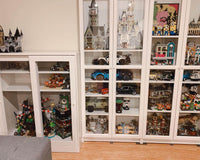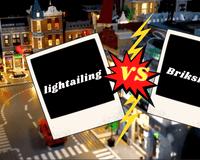Dreaming about a vintage sports car and always wanting to lay your hands on its sleek steering wheel might just be real with the Lego Porsche 911 10295 set. The legendary coupe and convertible Porsche 911 has always been a point of interest to many car enthusiasts out there and those who share an equal enthusiasm about Lego building have something creative to satiate that interest. Straight out of the Lego Creator Expert series, which is deemed to be famous for the difficulty level kept high enough for experts, this set brings the same timeless glamour that the original car had when released in 1964.
Those who have followed the variants of the Turbo and Targa series of Porsche, namely 911 Targa 4 and 4S, as well as 911 Turbo, Turbo Cabriolet, Turbo S and Turbo S Cabriolet, will find this expert-level Lego model perfect for customization. As you follow the Lego Porsche 10295 review, you will understand how the model with 1458 Lego pieces turn into the gateway car in the coupe and convertible version in turn.
The price is set at GBP 119.99 and USD 149.99 for buyers at different corners of the world while it is age-appropriate for anyone aged 18 or above, thanks to the complex building procedure. If you have experience of building cars from the Lego Speed Champions or the Lego Technic categories, this set designed by Mike Psiaki will enthrall you more with the detailed configurations and stylish look.

All You Need To Know About Porsche 911 10295 Set
Coming to the box weighing a bit over two kilograms with a dimension of 34.29cm x 15.24cm x 10.16cm, you will find eleven numbered (between 1 and 10) bags. There is another bag containing trans clear elements for windscreen and the tyres of the car so that those are safe from any scratches.
The instruction book has details regarding both Targa and Turbo models of this two-in-one set on the first few pages. The graphical representation and the instructions in the coffee-table book will seem quite simple for Porsche enthusiasts and fans of classic cars. The design details for the Porsche Lego sets are included with the trivia and commentary by the designer. You will not find any additional sticker in the set as each decorated element comes printed on the tile.
Once fully assembled, the car model will be more than four inches in height and six inches in width while the length will be 13.5 inches. Before moving on to the building process, here are the highlights of the set –
- Whether you create the convertible Targa model featuring the removable roof stored beneath its hood and the Targa bar or the Turbo model famous for the turbochanged engine, the design will more or less be the same.
- The exterior to the car gets a realistic look with those iconic bumpers for front and rear sides, three printed license number plates and the Porsche logo and the angled headlights.
- The interior to the car is equipped with gearshift, functional steering, emergency brakes and tilting seats, which can be adjusted accordingly. The color scheme is made realistic with nougat and dark orange.
- As mentioned earlier in this Lego 10296 review, you can assemble, disassemble and reassemble the set into two versions of Porsche cars. For the Turbo model, you will find the wide axle for the rear side, the integrated spoiler for the rear-mounted classic turbocharged flat-six engine and intercooler that offer air-cooling.
- For the Targa convertible car, you get the Targa Roll Bar, rear glass cover behind the driver cab and the removable roof that gets fit underneath the front hood.
 Building Experience With The Porsche 911 10295 Set
Building Experience With The Porsche 911 10295 Set
Created in quite a similar way as many large-scale Lego sets, the Porsche 911 set features several Technic elements that will be easier to assemble for those with prior experience. Now that you know the tidbits about the set, it is time to follow the building steps in the Lego Porsche 911 review –
- Including the Technic bricks for the chassis is conventional with 2x4 dark orange curved slopes while assembling the axles separately by accommodating alternative rear axles and steering will seem a unique approach to you.
- An eye-catching feature is the curved bodywork of the set that is extended beneath the car body. The flooring for the interior is done with black bricks, so are the seats that are attached above chassis.
- Combine rounded 2x4 tiles and Technic pins to create an elaborate and rigid angled frame around the seats –this will seem easy if you have combined Technic and System construction methods in any Lego model earlier.
- The construction of the rear side is a bit complicated as the bumper consisting of a few segments attached in different directions will create curved and layered slopes tucked between the curved plates. The unique shape of Porsche 911 is thus achieved and now you can mount the two curved shells to complement brake lights.
- The engine components for Targa and Turbo variants are swapped although air-cooling mechanism remains the same. Connect click hinges from the first bag to attach the front seating arrangements sideways.
- Add two linkages to steering knuckles for the steering mechanism of the front axle and use 4 Technic pins to attach the bodywork beyond forward axle. This will remind you of assembling the Ford Mustang 10265 set. Same goes for mounting the windscreen with hinges and assembling the doors made up of 2 distinct layers for smooth closing and opening.
- Use inverted 1x3 slopes to create wheel arches and position angled headlights in between. Add curved 4x4 tiles outside each arch to cover the angular slopes beneath them and get a rounded shape.
- Once the bonnet and wheel arches of the Lego Creator Porsche 10295 are completed, you will find that the instruction book has separate directions for the Turbo and Targa variants. 8thand 9th bags are for Turbo while 8th and 10th bags are for Targa.
- While the angled segments give support to rear pillars by forming a slope that connects the roof with the bunker, you will notice that their transition is so effective that the windscreen gets suspended effectively in the rear side between them. The vacant clips from the early construction stages connect to the windshield in this step.
- There are few more vacant clips connecting to the bodywork covering the engine and the spoiler. Nestled in the chassis and attached to a clip, constructing the rear axle will seem pretty fragile although the perfectly sized associated slot will give sufficient support.
- In case of the Targa, the axle (that is a bit narrower than that of Turbo) construction is the same, but the windscreen segment is not as it is connected to 2 inverted plates instead of vacant clips. As the clips remain concealed, the construction will be robust.
- A number of 1x2 grille tiles are used to connect to the slips for building the engine cover in such a way that the structure stands properly with convertible roof and rear windscreen. Just like the original Porsche convertible, the roof attached by two clips permit easy removal and attachment of the hood.

Now, you might have understood the building process for both the models and therefore, the finished structure comes with some highlights. Be it the flared wheel arches and curved bodywork that every Porsche 911 Turbo features, or the smooth curve formed by rear bumper and roof, the white color scheme with the contrasting black accents or the distinctive indicators and headlights –there is no dearth of surprise, especially when you add Lego Porsche lights.
- Added in 2020, the 1x4x3 bow will look appealing with the trans-orange light. The black stripes like that in the original car with integrated curved 3x3 arch bricks will give an aerodynamic shape. The detailed Porsche emblem on bonnet is another striking feature.
- Grille tiles behind indicator lights create an appropriate texture and transition between wheel arches and skirt come out smoothly. Round headlights are seamlessly attached and the black rims have five spokes matching the source material.
- As you open the bonnet, 1x6 black tile and tan bricks are revealed. Storage bay is fully empty and neat. The torsion bar is covered with 1x1 black slopes. Curved 3x3 corner plates create the realistic door mirrors while internal upholstery and fabric linings of the doors are created with nougat bricks.
- Dashboard in dark orange color scheme features 4 printed dials by the gearstick and handbrake while the articulated levers look stunning. Perfectly angled 1x2 grille slopes connect roof and rear pillars. You will see printed windows for the rear panel.
- Lift the spoiler to access the horizontal intercooler above the cooling fan and air cleaner housing. The silencer has flexible hose and orange stripe complementing the housing.
- The Porsche Marquee within curved lights are in opaque orange scheme and looks unique with 1x2 trans clear tiles creating the reverse and brake lights.
- Stuttgart city license code is featured in one plate as it is the headquarter of Porsche while the other two codes feature Gunma Prefecture for Japanese license and P51AK3 as shown in Volkswagen Beetle 10252 and Ford Mustang 10265 sets.
- 5x4x2 trans clear panels are used for the rear windscreen of Targa model and it has enlarged silencer and upgraded air cleaner.
Lighting Up The Porsche 911 10295 Set
Now that you have finished building the car, you can light up Lego easily without learning electrics as the kit is created in a plug-and-play design. Any Lego enthusiast aged six or above should be able to add the lights from Briksmax or Lightailing. The lighting kit for Porsche 911 10295 comes in a hardcover box that contains several plastic packets wrapped in bubble sheets to prevent any handling damage and on opening each, you will find high-quality LED lights and premium lighting accessories packed separately.
There is a remote control that has power on/off button, reset, music mode, three sound volume modes, three brightness control modes, 1 to 8 buttons that let you choose which lights to flash and three light modes marked with A, B and C. in X1 mode, the LEDs will always glow regardless of day and night and in X2 mode, the lights will flash. You will get warm white and yellow lights for the headlights taillights and interior while red LEDs are for the tailgate lights and third brakes.
The Lego Porsche 911 lights are to be connected with the cables that are passed between stubs for preventing any damage and ruining the outer look. Arrange batteries in advance, for the kit does not include any for the AA battery pack. The expansion boards and Adhesive Squares are to be installed properly and the USB cable can be connected to the hub while the main power runs at a voltage below 5V.
Just like the Lego set, the light kit will also guide you during the installation with the universal instructions with illustrations. Keep the user guide for later use and the after-sale card as 2-year warranty.
















